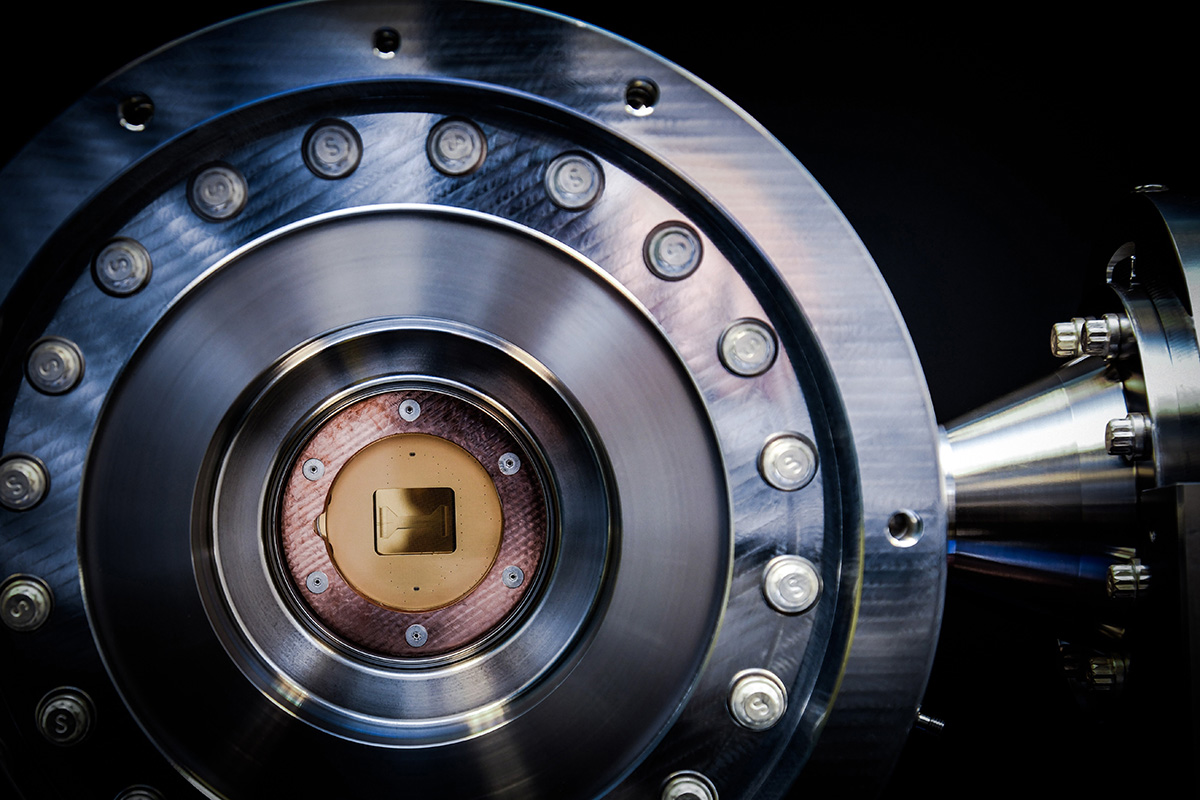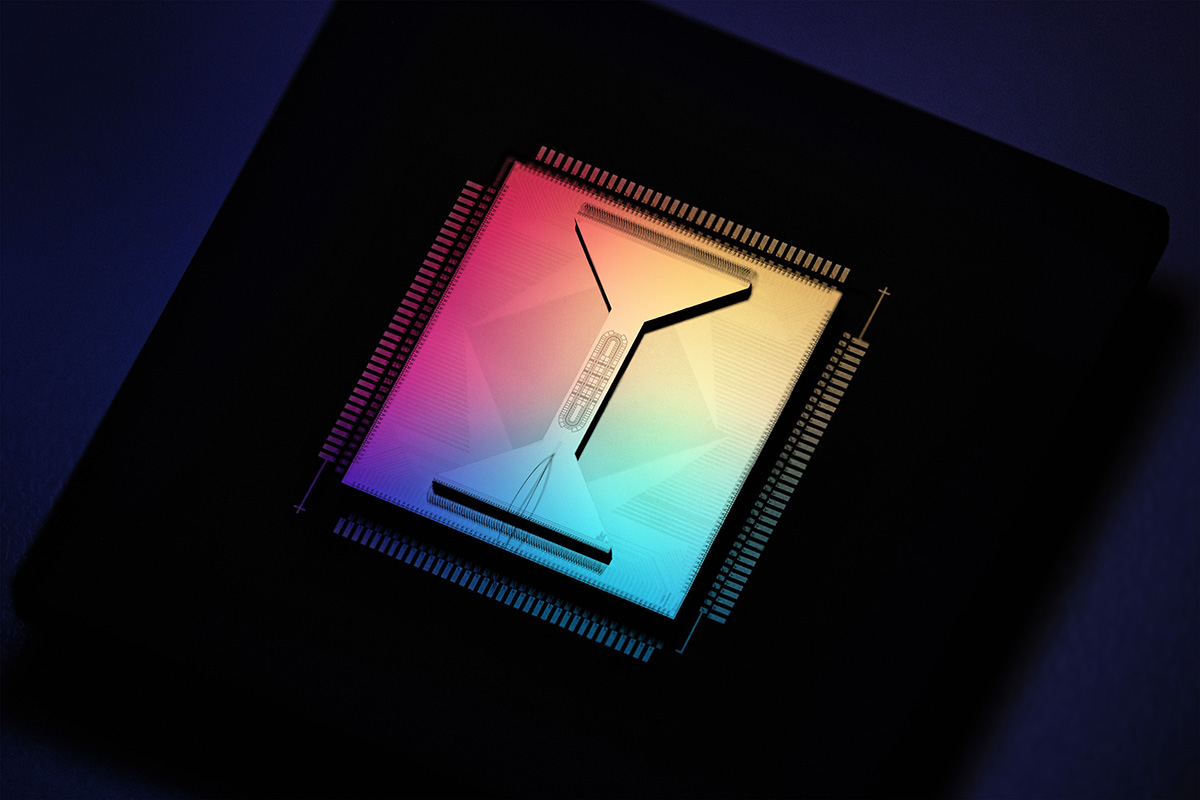A view of Quantinuum’s trapped-ion computer, including the H2 processing chip. Scientists from the company have reported the demonstration of high-fidelity, fault-tolerant teleportation of a logically encoded quantum state, with real-time quantum error correction. [Image: Quantinuum]
A team at the quantum computing company Quantinuum has reportedly achieved the high-fidelity, fault-tolerant teleportation of a quantum state encoded in a so-called logical qubit (Science, doi: 10.1126/science.adp6016). The researchers argue that their feat—accomplished using Quantinuum’s H2 trapped-ion processor and its “quantum charge-coupled device” (QCCD) architecture—constitutes “the state of the art” in quantum error correction, and an important step on the road toward scaling up trapped-ion platforms into universal, fault-tolerant quantum computers.
“To boldly go …” with quantum information
In any story on quantum teleportation, a reference to the transporter technology of the vintage TV series Star Trek seems almost obligatory. But there’s a significant difference in what’s actually being transported. The sometimes arcane online commentary of Star Trek fans has generally concluded that the show’s fictional transporter sends real physical matter (“dematerialized” into an “energy pattern”) from point A to point B. With quantum teleportation, by contrast, it’s all about sending not matter or energy, but information.
In the simplest case, quantum teleportation uses a pair of previously entangled, physically separated quantum bits, or qubits, as endpoints on a sort of highway to transport the quantum information of a third qubit. The information-carrying third qubit is initially combined with the first entangled qubit, at the sender end, changing its quantum state. Through the magic of quantum entanglement, the change to the quantum state of the sending qubit instantly changes the quantum state of the entangled other qubit at the receiving end.
An analysis at the receiving end is then used to back out the original quantum state of the information-carrying third qubit. And voila! The third qubit is effectively teleported from the sending to the receiving location. (The system gets around special relativity’s prohibition on faster-than-light information transfer, it turns out, because re-creating the original measurement at the receiving end requires the transfer of two bits of classical information.)
From physical to logical
The notion of quantum teleportation is not a new one—it was first proposed in 1993 in a PRL paper by Charles Bennett, Gilles Brassard and colleagues. Soon afterward, in 1997, a team led by future Nobel laureate Anton Zeilinger reported the first experimental quantum teleportation, a result followed up by multiple subsequent demonstrations. Quantum teleportation has generally been viewed, along with entanglement, as a key functionality for scaling up quantum computers and networks, as it enables nonlocal transfer and interactions of quantum information.
Quantum teleportation has generally been viewed, along with entanglement, as a key functionality for scaling up quantum computers and networks.
The problem is that previous teleportation demonstrations have involved individual physical qubits, and the fragile nature of quantum information means that the process is highly prone to error. One way to get around such errors would be to encode the quantum state not in a physical qubit such as a single photon, atom or ion, but in a so-called logical qubit. Such a qubit is essentially an ensemble of multiple physical qubits whose collective state mimics that of one qubit—but on which quantum error correction (QEC) codes can be run on the fly to keep the system as stable and fault-tolerant as possible. “As fault tolerance is essential for large quantum computations,” the authors behind the new study write, “logical teleportation becomes truly enabling.”
Logical teleportation with error correction
The Quantinuum team now says it has demonstrated one version of such an enabling result. In a blog post accompanying publication of the new research, the firm calls it “the first time that an arbitrary quantum state has been teleported at the logical level,” and “the first demonstration of a fully fault-tolerant version of the state teleportation circuit using real-time quantum error correction.” The company set out on this path, according to the post, at the behest of the US Government Intelligence Advance Research Projects Activity (IARPA), which sought a demonstration of high-fidelity teleportation coupled with QEC to help drive forward the “state of science” for universal fault-tolerant quantum computing.
The Quantinuum H2 processing chip. [Image: Quantinuum]
The new experiments involved using Quantinuum’s H2 trapped-ion processor, which includes 32 physical qubits, to create and teleport logical qubits with error correction, under two separate schemes. One scheme, using so-called transversal circuits, involved the inclusion of error-checking “QEC gadgets” as part of the circuit, to enable errors to be caught and corrected in real time. The other scheme, “lattice surgery,” is a simpler setup relying on 2D nearest-neighbor interactions that is logically equivalent to transversal circuits but uses fewer resources.
The company maintains that the ability to test these two different circuit types testifies to flexibility of the Quantinuum processor’s QCCD architecture. This architecture was first proposed in the early 2000s by Nobel laureate David Wineland and others as an approach for large-scale trapped-ion computers, and realized in 2021 by researchers at Quantinuum’s precursor, Honeywell Quantum Solutions. The QCCD scheme involves the storage and transportation of qubits as charged, mobile ions manipulated by electric fields within the quantum processor, analogous to a CCD’s storage and processing of image information as movable electric charges.
In addition to the hardware, Quantinuum also says the recently reported work rests on development on the software side. The study used an internally developed programming language dubbed Simple Logical Representation (SLR) that’s designed to run on logical qubits, in contrast to existing codes focused on physical qubits. “Someday,” the company maintains in its blog post, “all quantum algorithms will need to be run on the logical level with rounds of quantum error correction.”
More work needed
While the researchers believe their study represents “the state of the art in experimental QEC,” it is clearly still a work in progress in several respects.
While the researchers believe their study represents “the state of the art in experimental QEC,” it is clearly still a work in progress in several respects. For one, while the transversal-circuit experiments showed high process fidelity—essentially, how accurately the measured result reflects the desired one—that measured fidelity, at around 0.975, was slightly below the 0.989 fidelity sported by the physical-qubit teleportation the authors used as a benchmark. Ironically, the slightly lower fidelity for the logical teleportation may have been due to the introduction of the “QEC gadgets” themselves; the addition of those extra error-checking circuits apparently added noise to the system as a whole, even as they were assiduously rooting out potential errors in the quantum state itself.
Further, the authors acknowledge that “more work is needed” to actually demonstrate the potential suppression of quantum errors implicit in the real-time QEC used in the experiments. The team believes that “fundamental limitations are not an issue,” however, and that noise can be pounded out of the system by tweaking wavelengths and power of the ion-trapping lasers and through a variety of other hardware and software optimizations.
Meanwhile, the researchers conclude, their new study “lays groundwork for the experimental investigation of the fault-tolerant implementation of quantum algorithms through QEC.” Future work toward that end, they add, could include better optimizing resource requirements for needs such as state generation and fault tolerance; co-design of computer hardware and software; and “tailoring QEC protocols to advance large-scale quantum computing.”


